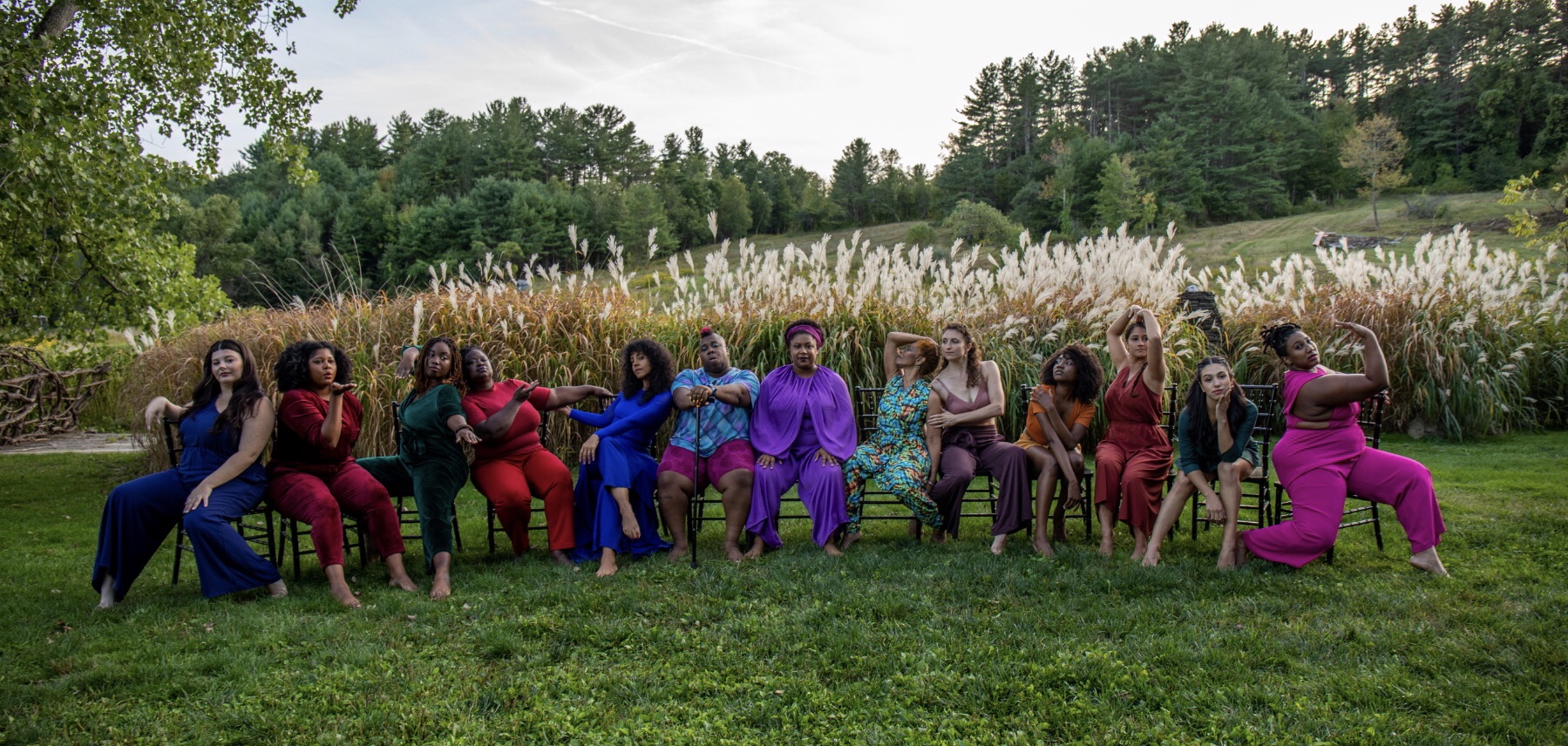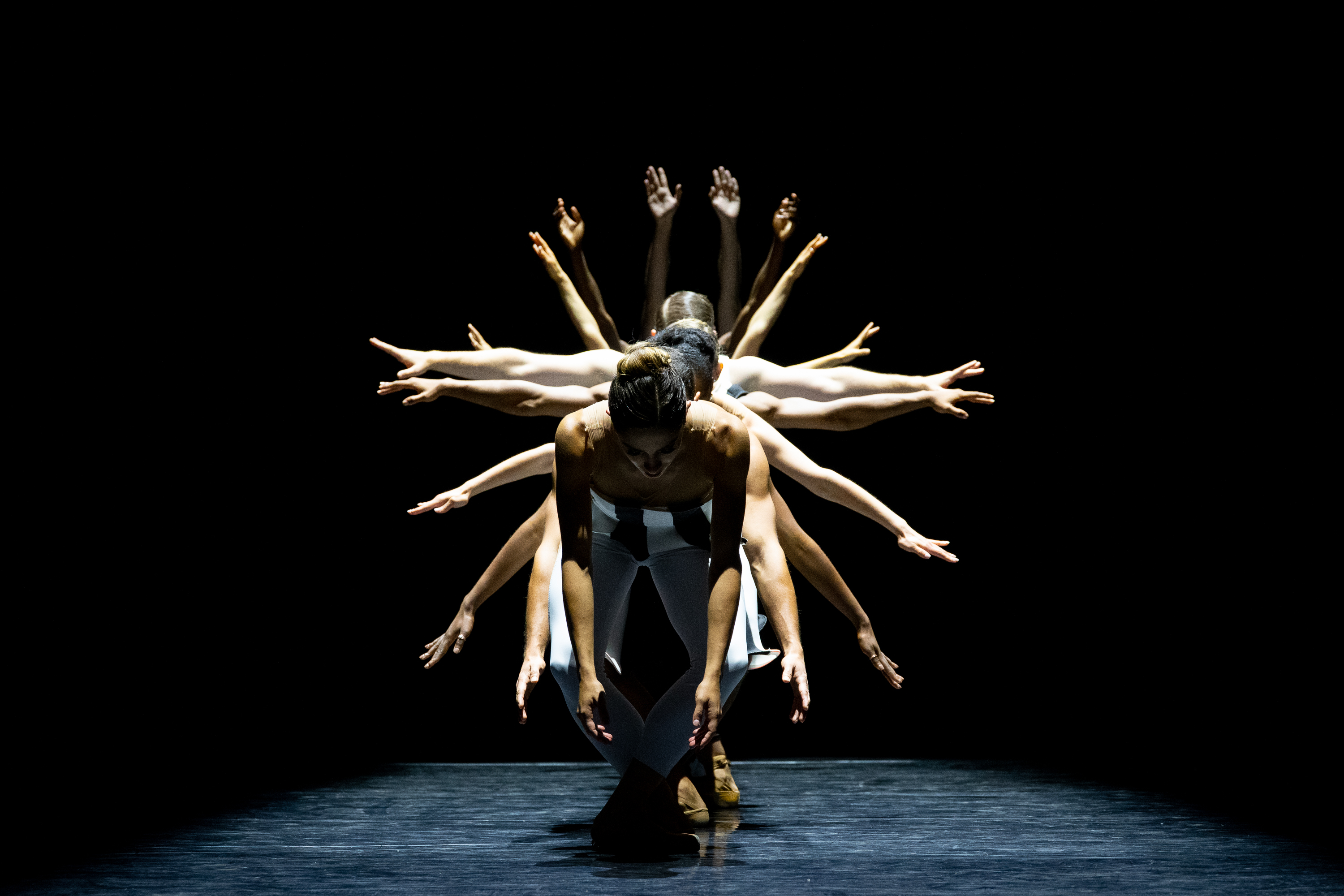“CUSTODIANS OF BEAUTY”: WE ARE NOT SUPPOSED TO UNDERSTAND
By Luella Christopher, Ph,D.
Pavel Zustiak and Palissimo Company
American Dance Institute
Rockville, Md.
November 20, 2015
Mental somersaults. A day after watching “Custodians of Beauty”, I’m still doing them. This is exactly what Pavel Zustiak wants: enticement of the audience, both figuratively and literally, into his work. We’re mad, sad, glad, perturbed, confused, then affirmed by what we see on stage over the course of ninety minutes. It’s not just the cutting-edge choreography but the whole picture: a driving computerized sound score; stark lighting shifts and dramatic visual projections; moving panels that portray different colors, motifs and moods; fragments of unspoken dialogue projected on the back wall; primal, largely symmetrical poses among the three dancers; passive confrontation and the lack of palpable interaction; sinewy, languid and deliberate moves that comment on the human (or animistic) condition.
Slovakian-born Zustiak told writer/psychiatrist Velleda C. Ceccoli in January 2013 that when striving to make pieces that “resonate and stir us”, he chooses universal topics that address human suffering, joy, struggle and relationships. At the same time he labels himself an abstractionist and reductionist. As stated to Milena Fisher of Creativity Post (May 19, 2014), Zustiak eschews the difficulty that dance encounters when trying to tell a story by frequently opting for actors over dancers. Actors have “an easier time sustaining the intention behind movement” since they are less constrained by training in precise technique. Zustiak avoids explicit emoting because “the more I feel on stage, the less space I give the audience to feel”. He opines: “People are like snowflakes”; the “many different ways of expressing ideas” countervail the uniform lines of ensemble work that typify classical ballet.
Greatly influenced by Pina Bausch – who performed in his hometown of Kosice in 1987 – Zustiak morphed from acting in a children’s television series to a degree in business to dance. We’re invited to “join in the play, live the emotion, enter the conversation and embody the surprise” as becomes obvious when performer Justin Morrison in the Nov. 20th world premiere mounts the steps and pulls an audience member onstage without offering her an ounce of stage direction. (She stands alone gamely until the cast finally returns to the scene.)
Zustiak lived through the 1989 “Velvet Revolution” that brought dissident playwright Vaclav Havel to the presidency of post-Communist Czechoslovakia – a movement distinguished by huge mass demonstrations and the public rattling of keys. (Later, the “Velvet Divorce” split his country into two nations, the Czech Republic and Slovakia.) Zustiak reflected after the performance in my discussion with him that his onstage moving panels were coincidentally encased in velvet. Some of his previous works, including the trilogy “Painted Bird” (performed in its entirety from Sept. 12-16, 2012 at Ohio State University’s Wexner Center for the Arts), capitalized on the notion of an orphan working his way through war-torn Poland.
“Custodians of Beauty” begins with projected streams of light in color, then black and white, moving across the front of the stage. Rumbling and occasionally slicing sounds introduce the score by violist and composer Christian Frederickson – a portent of the repetition to come, both in the music and the movement. We see “WORD” projected on the back wall. On the darkened stage, we barely discern an amorphous mass that could be a giant worm or caterpillar moving slowly until it breaks into three pieces. My guest for the evening interpreted the imagery as scriptural: “In the beginning was the Word”.
The three performers slide up and down the back wall, moving in a continuum with a few accents like outstretched arms. We never know who or what they represent: insects, animals or aliens, humans, sea creatures or underwater formations such as coral. Their repetitive motions include fluttering fingers, jiggling derrieres, short extensions and frenzied, thrusting arms and contortions with feet turned in. They continue to move as a “glob” yet also separate from each other. Frequent lighting blackouts and even smoke wafted over the audience “displace, migrate and transform” the piece into multiple vignettes that keep us guessing as to what might happen next. The closest the trio comes to touching occurs when the two male performers stand behind the female (Emma Judkins) and “trace” her body from bottom to top. One of the males lurches his torso like a sea creature. Judkins thrusts herself into several sharp extensions of the leg behind her body, then rocks back and forth in an upright position – mostly on her toes.
A series of projected sentences provokes intentionally: “my fucking mundane existence”, “thinking of dessert the whole time”, “we should be rioting”, “like a moth behind the pane”. Also, [angry silence]. Briefly, the pacing changes when the three performers – all clad in sneakers now – are shifting weight in unison, one foot to another. It’s the only energetic, slightly syncopated rhythm of the evening after an hour of monotonous 2/4 rhythms with every movement ON THE BEAT.
The female slows down a little and dances intentionally BEHIND the beat, as the performer Judkins later confirmed to me. She executes a fractured jete en tournant and whirls in a circle around herself. Morrison rolls on the floor and transits again to slow moves. Nicholas Bruder resumes his signature hyper-frenzied jabs and stabs. Each one displays a different pace now, with Judkins somewhere in between the two extremes. Bruder stands alone in the finale, waving an oversized dark flag. We are left pondering whether this represents an illusion to the Czech independence movement. Indeed, any recent or ongoing rebellion against national leadership figures wielding power over the citizenry.
“Custodians of Beauty” is difficult at times to digest, and it’s entirely possible that audience comprehension is not Zustiak’s intention. Nonetheless, his display of dance patterns in predominant monotones captures the viewer since the outcome is so uncertain.
Copyright © 2015 by Luella Christopher




